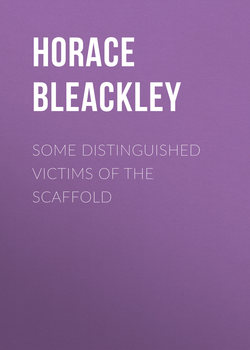Читать книгу Some Distinguished Victims of the Scaffold - Bleackley Horace - Страница 1
ОглавлениеPREFACE
No apology is needed, save that which the consciousness of inadequate work may call forth, from him who writes a history of great criminals. Since the lives of so many whose crime is their only title to fame have been included in the Dictionary of National Biography, it is inevitable that some of these old stories shall be re-told. Already the books of Charles Whibley and J. B. Atlay, as well as the newspaper sketches of W. W. Hutchings, have advanced this portion of our bibliography to a large extent. By a judicious selection some rare human documents and many an entrancing tale may be found in the crimson pages of the Tyburn Chronicle. The dainty squeamishness that put Ainsworth into the pillory, not because he had written a clumsy novel, but because he had dared to weave a romance around the grisly walls of Newgate, would be out of place in an age that will listen to ballads of a drunken soldier, and reads our women’s stories of the boudoirs of Mayfair.
Without a knowledge of the Newgate Calendar it is impossible to be acquainted with the history of England in the eighteenth century. On the other hand, to him who knows these volumes, and who has verified his information in the pages of the Sessions papers and among the battles of the pamphleteers, the Georgian era is an open book. No old novel gives a more exact picture of a middle-class household than the trial of Mary Blandy, nor shows the inner life of those on the fringe of society more completely than the story of Robert Perreau. While following the fate of Henry Fauntleroy we enter the newspaper world of our great-grandfathers. And as we look upon these forgotten dramas, the most illustrious bear us company. For a time Wordsworth and Coleridge chat of nothing but the Beauty of Buttermere and rascally John Hadfield. Dr Johnson thinks wistfully of the charms of sweet Mrs Rudd. Boswell rides to Tyburn in the same coach as the Rev. Mr Hackman, or persuades Sir Joshua to witness an execution. Henry Fielding lashes the cowards who strive to condemn a prisoner unheard. To all who desire to understand the eighteenth century the Newgate Calendar is as essential as the Letters of Walpole.
In making a selection from the dozen or more causes célèbres that stand out in special prominence from the rebellion of ’45 to the death of George IV. the choice is not difficult. It is apparent that the stories of Eugene Aram, Dr Dodd, and John Thurtell must be omitted, for all have been told adequately in recent years. Little that is new or interesting can be found in the tale of mad Lord Ferrers, except that he was not hanged with a silken rope. Although the weird tragedy of the Rev. James Hackman sank more deeply into the popular mind than almost any other, the history of the brothers Perreau has been preferred, since Mrs Rudd appears a more attractive personage than the unfortunate Martha Ray. For similar reasons Wynne Ryland takes the place of Captain Donellan, and Eliza Fenning, naturally, has been excluded in favour of the Keswick Impostor. As to the rest, it is obvious – owing to the omission of the highwayman and those guilty of high treason such as Colonel Despard – that no more illustrious names can be found in the Newgate Calendar than Mary Blandy, Joseph Wall, and Henry Fauntleroy.
Each crime, moreover, bears the distinct impress of its epoch. None other but the dark night that separates a gorgeous sunset from the brilliant dawn could witness the sombre tragedy at Henley. While the nation begins its eager life as a young apprentice to trade, Tom Idle is found among the recreants, and many a sparkling macaroni like Daniel Perreau prefers to stake his all in Exchange Alley to pursuing laborious days. Wynne Ryland is dazzled by the birth of a most radiant springtide when the world becomes clothed in beauty, and man seems to have stolen the heavenly flame. Then comes the clash of arms and the strife of worlds, when the red giants are unchained, and the life of ten thousand men is naught in the policy of a statesman. With the story of the Maid of Buttermere we perceive again one of the spirits of the age – vain, ruthless Strephon in dandy attire pursuing his Phyllis, shallow-pated and simple. And last, the era of Henry Fauntleroy, when the nation has grown rich, and man must choose between the scarlet of the Corinthian, and the dull, sober garb of toil – a strange mingling of black and crimson.
In order to avoid an interruption of the narrative which a footnote must always cause, the editorial comments have been placed in the bibliography at the end of each monograph, to which those who differ from the author are requested to refer. Although the addition of the lists of authorities has robbed the book of due proportion, the fact that the useful adage “when found make a note of” has been observed will, it is hoped, cause the loss to be balanced by the gain.
The author wishes to acknowledge his obligations to Mr John Arthur for his kindness in verifying references in the British Museum; to Mr Isaac Edwards of Bolton for similar help; to the editors of the Henley Advertiser, the Carlisle Journal, and the Tiverton Gazette for access to the files of their newspapers; to the rectors of Henley, Feltham, Mottram, St Sepulchre’s, Holborn, and St Martin’s, Ludgate, for permission to consult the church register; to Mr Richard Greenup of Caldbeck for information concerning the Beauty of Buttermere; and to Mrs Bleackley for the list of Wynne Ryland’s engravings.
